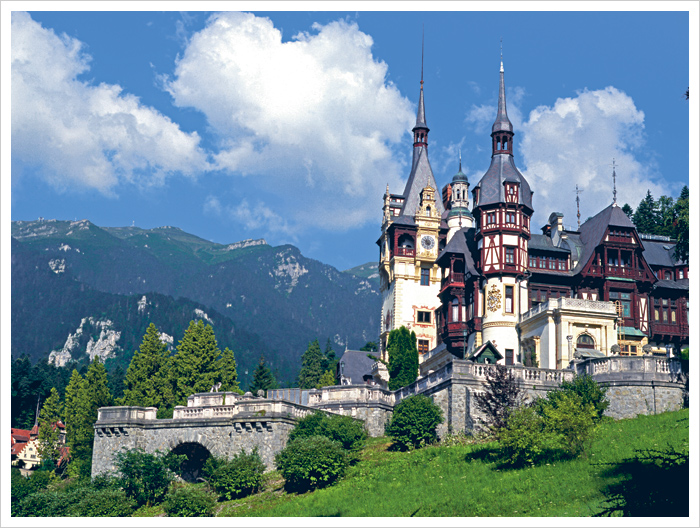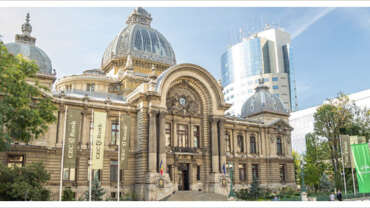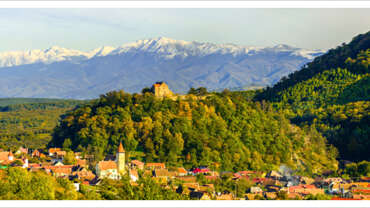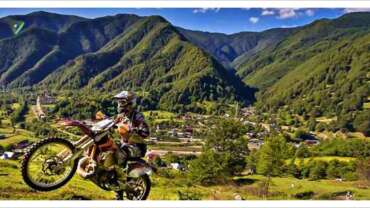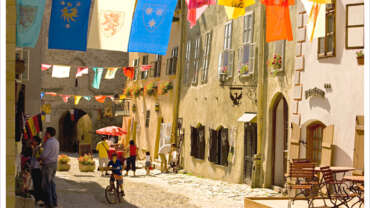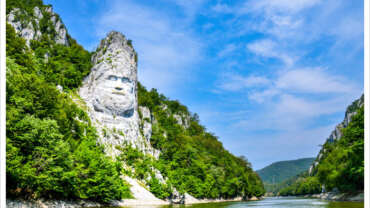Main Attractions of Romania
Black Sea Resorts
Warm climate, miles of sand beaches, ancient monuments, vineyards and modern resorts invite travelers to seriously consider Romania’s Black Sea Coast as their summer vacation destination.
Beaches, stretching from Mangalia to Mamaia, are dotted with fine resorts and hotels, and countless sports and entertainment facilities.
Remnants of ancient Greek culture as far back as the 7th Century, BC, when seafarers established trading colonies along the coast, are still being discovered.
Romania’s main sea resorts are centred on 45 miles of fine sand beaches and include Mamaia, Eforie, Neptun, Jupiter, Venus, Saturn and Mangalia.
The Black Sea coast has long been known for cures of arthritic, rheumatic, internal and nervous disorders. Eforie Nord and Mangalia Spas specialize in mud baths (the mud is taken from the area’s salty lake waters) as well as in world famous “Gerovital” and “Aslavital” original rejuvenation treatments.
Vacationers at Romania’s Black Sea Coast can also join organized trips from the seaside to a number of locations in the country, including the Danube Delta, the painted monasteries of Bucovina, to the nation’s capital city, Bucharest, or to nearby Bulgaria, Greece and Turkey.
Romania’s Castles and Fortresses
Romania’s collection of castles and fortresses perhaps best illustrates the rich medieval heritage of the country. While castles built from the 14th to the 18th centuries are strong and austere fortresses built mainly for defense against invaders, those erected beginning in the late 1800s are imposing and luxurious. The most popular include the 14th century Corvin Castle, built on the site of a former Roman camp, the elegant 19th century Peles Castle with its 160 rooms filled with priceless European art and, of course, the Bran Castle, built in the mid-1300s and legendary home to Bram Stoker’s Count Dracula.
As a result of almost nine centuries of Saxon presence, Transylvania, located in central Romania, claims a cultural and architectural heritage unique in Europe. This region is home to nearly 200 Saxon villages, churches and fortifications built between the 13th and 15th centuries. Seven of the fortified Saxon churches (in Biertan, Calnic, Darjiu, Prejmer, Saschiz, Valea Viilor, and Viscri) were designated by UNESCO as World Heritage Sites. A visit to these quaint villages, placed amidst lush farmland and green rolling hills, will give you a taste of the long-gone medieval times.
The Danube Delta (Delta Dunarii)
The mighty Danube River flows 1,788 miles from its springs in Germany’s Black Forest to the Black Sea. Just before reaching the sea it forms the second largest and best preserved of Europe’s deltas: 2,200 square miles of rivers, canals, marshes, tree-fringed lakes and reed islands. The Danube Delta is a wildlife enthusiast’s (especially a bird watcher’s) paradise.
Travelers can spend three or more days exploring its passages, teaming with the highest concentration of bird colonies in all of Europe. The maze of canals bordered by thatch, willows and oaks entangled in lianas, offers the perfect breeding ground for countless species of birds, some of them from as far away as China and Africa. Millions of Egyptian white pelicans arrive here every spring to raise their young, while equal numbers of Arctic geese come here to escape the harsh winters of Northern Europe.
Some 300 species of birds make Danube’s Delta their home, including cormorants, white tailed eagles and glossy ibises. The bird watching season lasts from early spring to late summer. Birds are not the only inhabitants of the Delta. There is also a rich community of fish and animals; from wildcats, foxes and wolves, to even an occasional boar or deer. Altogether, 3,450 animal species can be seen here, as well as 1,700 plant species.
Medieval Towns
Central Romania encompasses what is popularly known as Transylvania – a place that immediately brings to mind the legend of Count Dracula. While the legend is certainly intriguing and a genuine tourist attraction, the region has much more to offer. Some of Europe’s best-preserved medieval towns, most notably Sighisoara, Brasov and Sibiu, are located here.
Visitors can marvel at Transylvania’s unique architectural treasures, such as castles, fortified churches and centuries-old houses, while exploring sites where more than 900 years ago Saxon craftsmen and merchants established powerful and rich citadels.
During the middle of the 12th century Saxons came to the area from the Luxembourg, Lorraine, Moselle, Rhine and Wallonia regions of northwestern Europe. They called their new home ‘Siebenburgen’ (Seven Fortresses – in Latin Septem Castra) after the seven major walled towns they built here:
Brasov – Fringed by the peaks of the Carpathian Mountains and resplendent with gothic, baroque and renaissance architecture, as well as a wealth of historical attractions, the medieval city of Brasov (find out more about Brasov), located just three hours north of Bucharest, provides a great introduction to the region. Among Brasov’s best know historical and cultural attractions are the Council Square, the beautiful St. Nicholas Church, the Black Church – the largest Gothic church east of Vienna – so named because of its dark walls which survived a devastating fire in 1689, and the Brasov Fortress. In close proximity to Brasov are the fortified churches at Harman (find more about Harman) , with its massive 13th century defending towers, and Prejmer (find more about Prejmer) , the biggest fortified church in Southeastern Europe. Visit Brasov’s many historic and archeological gems before heading for the medieval town of Sibiu.
Sibiu – Designated European Capital of Culture in 2007, Sibiu (find out more about Sibiu) retains the grandeur of its earlier days when rich and powerful guilds dominated regional trade. Explore the old city center with its upper town, home to most of Sibiu’s historic sites, and lower town, lined with colorful houses on cobblestone streets and bounded by imposing city walls and defense towers overlooking the river Cibin. Sibiu makes an ideal base for the exploration of the nearby countryside and villages. Located at the foothills of the Cindrel Mountains, a half-hour drive from Sibiu, is Marginimea Sibiului – a string of 18 villages, rich in architecture, history and heritage.
Sighisoara – Transylvania is also home to the exquisite medieval town of Sighisoara (find out more about Sighisoara), a perfectly intact 15th century gem with nine towers, narrow passageways and cobbled streets, burgher houses and ornate churches. A UNESCO World Heritage Site, Sighisoara is also the birthplace of Vlad Draculea, nicknamed Vlad the Impaler (Vlad Tepes), ruler of Walachia from 1456 to 1462. It was Vlad who inspired Bram Stoker’s fictional creation, Count Dracula. His house is just one of many attractions here. Others include: the Church on the Hill, with its 500-year-old frescoes; the Church of the Dominican Monastery, known for its Transylvanian Renaissance carved altarpiece, baroque painted pulpit, Oriental carpets and 17th century organ; and the Venetian House, built in the 13th century. In the nearby countryside, another UNESCO World Heritage town, 13th century Biertan (find out more about Biertan) , stands high on a hill as one of the largest and most impressive medieval strongholds in Transylvania.
Cluj Napoa – The western Transylvania city of Cluj Napoca (find out more about Cluj Napoca), tracing its origin back to the Dacian settlement of Napoca in 2nd century A.D., is today a vibrant cultural and university center. The main square, resplendent with 18th and 19th century buildings, is dominated by the 15th century St. Michael’s Church, one of the finest examples of Gothic architecture in Romania. The square is also home to the 18th century baroque Banffy Palace, housing the weaponry and Romanian painting collections of the Art Museum. Visitors who want to learn more about the region should check out the open-air section of the Ethnographic Museum of Transylvania, a true display of folk architecture. Spend an enjoyable evening at the Opera or attend a classical concert offered by the Cluj State Philharmonic.
Bistrita – Located at the foot of the Bargau Mountains, not far away from Borgo Pass which connects Transylvania to Bucovina, the town of Bistrita (find out more about Bistrita) is one of the oldest in the region. Saxon colonists, who settled in the area in 1206, helped develop the town into a flourishing medieval trading post. The old town’s quaint 15th and 16th century merchant houses, the remains of the 13th century fortress walls, and the city’s unhurried pace have preserved some of Bistrita’s once-thriving medieval atmosphere. Not to be missed attractions include: the 14th century Saxon Evangelical Church; the arcaded Sugatele row; the Silversmith’s House; Coopers’ Tower; and the County History Museum.
Medias – The medieval centre of the ancient settlement of Medias (find out more about Medias) has a particular charm, with narrow winding lanes, centuries-old houses and a large pedestrian square. The fortified St. Margaret Evangelical Church, erected in the 15th century on the ruins of a Roman basilica, dominates the old town. The church, enclosed by two rows of walls and several defense towers (one of which served as prison cell for Vlad the Impaler in 1467), features three superb Gothic altarpieces, a colorful Baroque organ and some early 15th century frescoes.
Sebes – During the middle ages, Sebes (find out more about Sebes) was a flourishing economic and political centre. Like all Saxon medieval citadels, the town was renowned for its crafts and trade, serving from 16th to 18th century as a seat for the Transylvanian Diet. Main attractions include: the 12th century Evangelical Church; the 14th century Fortress; and the 15th century Zapolya House.
The Carpathian Mountains – National Parks
Romania’s national and natural parks, displaying a unique variety of landscapes, vegetation and wildlife, protect some of the largest remaining areas of pristine forest in Europe. Grasslands, gorges, subterranean caves, volcanic lakes, and extensive river network add to the richness of the park system that also includes the Danube Delta, a UNESCO Biosphere Reserve and Europe’s largest wetland.
Romania’s diverse natural landscapes offer numerous choices for exciting outdoor experiences. Travelers can walk through serene alpine meadows covered with scores of wildflowers, trek around glacial lakes, take in the lush-green scenery while horse riding or mountain biking, climb curious rock formations, photograph fossil traces of 15,000-year old cave-bear species, track gold eagles or other rare birds, study endangered flora, wander in the countryside, picnic in the fields, try your hand at traditional crafts, – or just relax in the home of a village family and sample wholesome, country fare with home made wine and plum brandy.
APUSENI NATURE PARK – The Apuseni Nature Park (Parcul Natural Apuseni) – known as the cavers’ paradise, protects one of the most interesting cave fauna in the country. Traces of the prehistoric man, as well as fossils of animals that lived in the Ice Age were found in several of the caves, along with rare bat populations. The higher ridges of the park are covered with spruce fir, while at lower levels the forest is dominated by mountain beech.
BICAZULUI GORGES – HĂȘMAȘ NATIONAL PARK – The Bicaz Gorges are famous for their 1000 ft. limestone rocks towering over narrow roads and passes. The road that slices through the Bicaz Gorges (Cheile Bicazului) is among Romania’s most stunning and spectacular.
For kayakers and fly-fishing enthusiasts the park’s main attraction is the Red Lake (Lacul Rosu), created in 1837 after a major natural landslide. Short and long walks provide access to the lake’s spectacular scenery and many fishing spots. The Bicaz Gorges offer a unique view of the Ceahlau Mountains.
CĂLIMANI NATIONAL PARK – Massive eruptive rocks and craters of old volcanoes in the Calimani National Park (Parcul National Calimani) are spawned over breathtaking landscapes, matched by the presence of large areas of natural ecosystems and the abundance of Swiss stone pine and juniper trees.
The Calimani Mountains features the highest massif in the Romanian volcanic chain, the Pietrosu Peak (standing at 6896 ft.).
The natural erosion process in the volcanic plateau has led to the formation of the unusual shaped 12 Apostles (Cei 12 Apostoli), Red Stones (Pietrele Rosii) and Nefertiti geological reserves.
CEAHLĂU NATIONAL PARK – Surrounded by watercourses and dam lakes, Ceahlau Mountain, the Olympus of Romania, displays an incredible concentration of flora – over 2,000 flower species, and wildlife. Fossil limestone, the rock formations Dochia, Cusma Dorobantului, and the Duruitoarea waterfall are just some of the main attractions in the park. The park is bounded to the east by the Bistrita River and Lake Bicaz, and to the south by the Bicaz River.
Some of the most exciting Romanian legends refer to the strange stone shapes spread around the peaks in the park. The Dochia rock formations are said to represent a mean old woman (“baba”) who came on Ceahlau to feed her sheep. Deceived by the sunny days of early spring, she took off, one by one, all her nine-sheepskin waistcoats. When the frost came, it turned both her and her animals into ice, which over the years transformed into the stones we see now.
PIATRA CRAIULUI NATIONAL PARK – Piatra Craiului Natural Park features the longest and highest limestone ridge in the country (over 15 miles long and 6560 ft. high). Bordered by glacial lakes, the ridge is regarded as one of the most beautiful sights in the Carpathians. The two-day north–south ridge trail is both challenging and rewarding. Starting at either Plaiul Foii in the northwest or Curmatura in the northeast, hikers climb up to the ridge along the narrow spine of the range. The descent at the southern end leads into a karst landscape of deep gorges and pitted slopes where water penetrating the rock has carved a series of caves.
The traditional villages of Magura, Pestera, Ciocanu, Sirnea, make for interesting starting points for the routes on the eastern slope and for getting in touch with the traditional Romanian way of life.
RETEZAT NATIONAL PARK – Hiking in Retezat National Park you may well lose your breath, not from the climb, but from the breathtaking views of nature at her wildest. Peaks of differing heights, many topping the 8,028 ft. mark (such as Peleaga Peak), provide hikers with plenty of challenges. Travelers willing to tackle them will have their efforts well rewarded.
Local communities and cultural sights from around the park area add a special value to that of the landscape and the biodiversity inside the park. The people in the villages of Salasu de Sus, Rau de Mori and Campu lui Neag preserve to this day the traditional lifestyle of the area.
The Painted Monasteries of Bucovina
Among the most picturesque treasures of Romania are the Painted Monasteries of Bucovina (in northeastern Romania). Their painted exterior walls are decorated with elaborate 15th and 16th century frescoes featuring portraits of saints and prophets, scenes from the life of Jesus, images of angels and demons, and heaven and hell.
Deemed masterpieces of Byzantine art, these churches are one-of-a-kind architectural sites in Europe.
Far from being merely wall decorations, the murals represent complete cycles of religious events.
The purpose of the frescoes was to make the story of the Bible and the lives of the most important Orthodox saints known to villagers by the use of images. Their outstanding composition, elegant outline and harmonious colors blend perfectly with the surrounding landscape.
Whether you are interested in religion, history, art or architecture, you will be intrigued by the construction and decor — exterior and interior — of these edifices.
The best-preserved are the monasteries in Humor, Moldovita, Patrauti, Probota, Suceava, Sucevita, and Voronet. Another, a small church, is located in the village of Arbore. Seven of the churches were placed on UNESCO’s World Heritage list in 1993. The eighth, Sucevita, is awaiting sanction to be added on the list.
Romania’s Medical Spas
Started by Romans and unique in Europe. Today Romania’s 70 natural spas provide relief for many medical disorders and illnesses including rheumatism, endocrine, kidney, liver, respiratory, heart, stomach and nervous diseases as well as nutrition, metabolism and gynecological disorders.
Romania is home to more than one third of Europe’s mineral and thermal springs. Natural factors are complemented — under attentive medical care — by physiotherapy, acupuncture, electrotherapy and medicines produced from plants.
Romania’s main spas include: Mangalia, Neptun, Eforie Nord, Covasna, Slanic Moldova, Vatra Dornei, Borsec, Herculane, Buzias, Sovata, Bazna, Ocna Sibiului, Baile Felix, Tusnad, Calimanesti and Govora.
Traditional Villages
The golden glow of the sun against the soft pastel houses; residents going about their business, tending the chickens, their vegetable gardens or sitting on the front porch can make an unforgettable scene. In villages and in the countryside, on lands dominated by ancestral castles, old fortresses and peaceful monasteries, life moves a little slower and follows ancient rhythms of tradition and culture.
It’s not unusual to see a farmer bringing his fruits to the marketplace in a horse drawn wagon or to encounter a village festival where the locals perform ancient rites of planting and harvest dressed in colorful traditional costumes. Cold, pure well water beckons the thirsty traveler from the roadside. Men kiss women’s hands in a courtly greeting unchanged for hundreds of years. Lush vineyards, first planted by Dacians – ancient inhabitants of Romania, yield fine wines.



